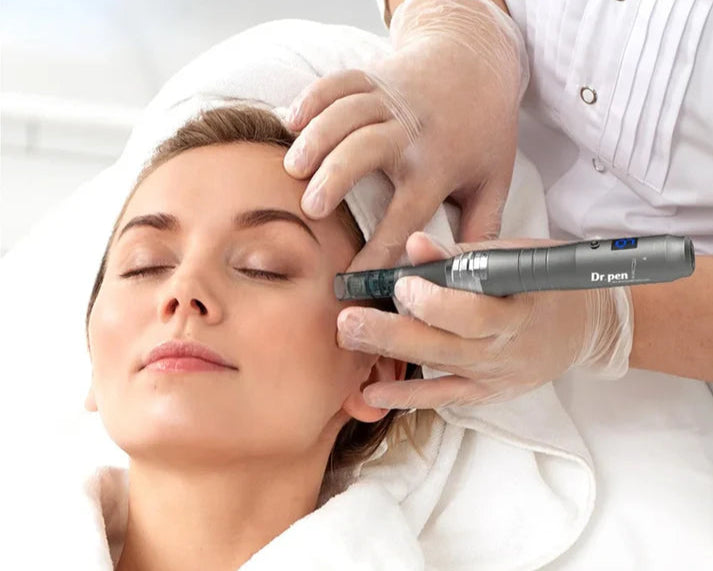Age spots, also commonly referred to as liver spots or sunspots, are a common skin concern that many individuals face as they age. These flat, brown, or black spots typically appear on areas of the skin that have had the most sun exposure over the years, such as the face, hands, arms, and shoulders. While age spots are generally harmless and do not require medical treatment, many people seek ways to reduce their appearance for cosmetic reasons. One such method that has gained popularity in recent years is the use of a microneedling pen.

A microneedling pen is a handheld device that uses fine needles to create tiny punctures in the skin. This process, known as microneedling or collagen induction therapy, is designed to stimulate the skin's natural healing response. As the skin heals from these micro-injuries, it produces new collagen and elastin, which can improve the skin's texture, tone, and overall appearance. But can this innovative skincare tool also help with age spots?
To understand how a microneedling pen might affect age spots, it's essential to delve into the underlying causes of these pigmented lesions. Age spots are primarily caused by ultraviolet (UV) radiation from the sun. When UV rays penetrate the skin, they trigger the production of melanin, the pigment that gives skin its color. Over time, repeated sun exposure can lead to an overproduction of melanin in certain areas, resulting in the formation of age spots.
Microneedling works by creating controlled micro-injuries to the skin's surface. These tiny punctures disrupt the skin's barrier, prompting the body to initiate its wound healing process. As part of this process, the skin produces growth factors and cytokines, which signal the fibroblasts (cells responsible for producing collagen and elastin) to become more active. This increased activity leads to the formation of new collagen and elastin fibers, which can help improve skin texture and reduce the appearance of fine lines and wrinkles.
In addition to stimulating collagen production, microneedling can also enhance the absorption of topical skincare products. When the skin's barrier is temporarily disrupted by microneedling, active ingredients in serums, creams, or other topical treatments can penetrate deeper into the skin. This can be particularly beneficial when using products that contain ingredients known to target pigmentation, such as vitamin C, kojic acid, or hydroquinone.
So, how does this relate to age spots? While microneedling itself does not directly target the melanin that causes age spots, it can indirectly help improve their appearance in several ways. First, by stimulating the production of new collagen and elastin, microneedling can help plump up the skin and reduce the visibility of pigmented areas. This can lead to a more even skin tone and a smoother texture, making age spots less noticeable.
Second, microneedling can enhance the efficacy of topical treatments designed to lighten age spots. By creating micro-channels in the skin, microneedling allows these treatments to penetrate more deeply, where they can work more effectively to inhibit melanin production and reduce pigmentation. This can lead to a more significant reduction in the appearance of age spots when compared to using topical treatments alone.
It's important to note that microneedling is not a quick fix for age spots. The process of collagen production and skin healing takes time, and multiple sessions may be required to see noticeable improvements. Additionally, the results of microneedling can vary from person to person, depending on factors such as age, skin type, and the extent of sun damage.
Before considering microneedling for age spots, it's crucial to consult with a qualified skincare professional. Microneedling is a medical procedure that should be performed by a trained and experienced practitioner. They can assess your skin, discuss your goals, and determine if microneedling is a suitable option for you. They can also provide guidance on the best topical treatments to use in conjunction with microneedling to target age spots effectively.
There are some potential risks and side effects associated with microneedling. These can include redness, swelling, and mild discomfort immediately after the procedure. In rare cases, more severe complications such as infection or scarring can occur. To minimize these risks, it's essential to follow all pre- and post-procedure instructions provided by your skincare professional. This may include avoiding sun exposure, using gentle skincare products, and applying a broad-spectrum sunscreen daily to protect the skin from further damage.
In addition to microneedling, there are other treatments available for age spots. These include topical creams and serums, chemical peels, and laser therapy. The best treatment option for you will depend on the severity of your age spots, your skin type, and your personal preferences. Your skincare professional can help you weigh the pros and cons of each treatment and develop a customized plan to address your specific concerns.
In conclusion, while a microneedling pen may not directly target the melanin that causes age spots, it can indirectly help improve their appearance by stimulating collagen production and enhancing the absorption of topical treatments. However, it's essential to approach microneedling with realistic expectations and under the guidance of a qualified skincare professional. With proper care and the right treatment plan, you can work towards achieving a more even skin tone and a more youthful appearance.

Share:
How to Choose a Microneedling Pen with Adjustable Needle Depth
How to Choose the Right Serums to Use with a Microneedling Pen